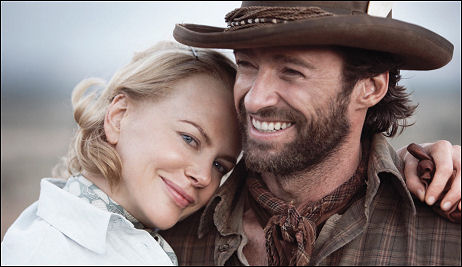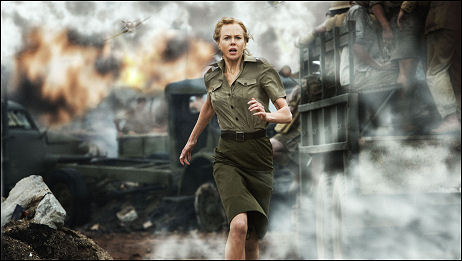“The character in the first hour of Benjamin Button was created in post, basically, with Brad inspiring it,” says director Spike Jonze in an interview with AICN’s Drew McWeeny. “[David] Fincher totally invented his own technique, and it’s insane. I’m always a little skeptical whenever you hear there’s a CG character [in a film], but I never even noticed it. It’s just this totally compelling, really charming character, you know, because he’s like a little boy inside an old man’s body, and the performance is amazing.”
Day: November 18, 2008
‘Nother One
Baz Luhrmann‘s long-awaited and over-budget Australia manages, against the odds, to avoid turning into one big sunburnt stereotype about Godzone country,” writes the Times Online‘s Anne Barrowlcough. “Instead, in what turns out to be a multi-layered story, it describes an Australia of the 1940s that is at once compellingly beautiful and breathtakingly cruel.
“Described as a cross between Gone with the Wind and Out of Africa it bears, in fact, little resemblance to either movie – apart from a similarly spectacular landscape as Out of Africa and a plot line that loosely resembles that of Gone with the Wind.
“In this case, Lady Sarah Ashley, a passionless English aristocrat (Nicole Kidman), inherits a vast cattle station in the Northern Territories only to find that the station is the target of a dastardly takeover plot.
“Much against her will, she is forced to enlist the help of a local stockman known only as Drover (Hugh Jackman), to save the station by driving her huge herd of cattle hundreds of miles across the Kuraman desert to Darwin. Which is then bombed by the Japanese.
“In the worst Mills and Boon tradition, Lady Sarah – whose emotions are as frozen as Kidman’s forehead – and the rough neck Drover loathe each other on sight but, as they endure the harsh and rather dusty travails of the cattle drive they quite quickly fall in love. She even teaches him to dance. Under a boab tree.
“But if it sounds shallow and predictable, Australia is, in fact, anything but.
“The cliches are saved by little jokes and asides, as if Luhrmann is saying ‘Yes, I know, but what can you do?’
“But what gives the film its heart is something else entirely. This is also the story of Nullah (Brandon Walters), a mixed race Aboriginal boy left orphaned by the inhumanity of Australian law. The 1940s was the time of the Stolen Generation, when mixed race children were banned from living either with their Aboriginal families or within the white community, but were taken from their homes to be brought up in church missions.
“Nullah’s increasingly frantic attempts to escape from the ‘coppers’ and his symbiotic relationship with his grandfather, the mystical King George, played with awesome power by the renowned Aboriginal dancer and musician David Gulpilil, is treated with a stark honesty and is what actually makes this film truly Australian in both its best and its worst sense.
“Brandon, 13, was discovered by Lurhmann in his local swimming pool in the West Australian town of Broome and he plays Nullah with a combination of mischief and tragedy that may turn him into the real star of the film, despite – or perhaps because of – the fact that he has never acted before.”
Stratton’s Take
Australia “is not without flaws, it’s not the masterpiece that we were hoping for, but I think you could say that it’s a very good film in many ways,” says The Australian‘s David Stratton, who’s obviously writing from a kind of Down Under home-team perspective.

“[But] while it will be very popular with many people I think there’s a slight air of disappointment after it all.
“Like his earlier films Strictly Ballroom, Romeo+Juliet and Moulin Rouge, Australia shows Baz Luhrmann as a very theatrical director. He has a great eye for compositions and the film is beautifully shot by Mandy Walker, but there’s theatricality about the film which is a bit off-putting at the beginning. The early scenes, even the first 20 minutes or so of the film, are handled in a slightly artificial, arch manner which doesn’t sit well with the outback locations and the natural settings of the story.
“It’s all very well to be artificial when you’re dealing with a theatrical concept like Moulin Rouge or even Strictly Ballroom, but it doesn’t really work so well when you’re doing the same sort of thing here, so there’s something that’s just a little bit off key about these scenes. Then once the cattle drive gets under way either you get used to it or that aspect of it is played down because the remainder of the film is much stronger in a rather conventional way.
“I have to say, there are a lot of cliches in the script, a lot of familiar elements from other films of the past — The Wizard of Oz and the song ‘Over the Rainbow’ are heavily referenced — and it’s as though the film is aimed at not so much an Australian audience but an international audience, and especially an American audience.

“I will say that the acting is of a very high level, especially given that some of the actors have been encouraged to perform in this rather stylized, theatrical way. Nicole Kidman does a very good job as she develops from this very stiff, awkward, naive Englishwoman to become a really warm character at the end of the film. And Hugh Jackman has tremendous charisma and charm.
“The supporting cast is particularly good. Jack Thomson as the alcoholic accountant for the property gives a lovely performance, Bryan Brown is a terrific as the cattle baron although his demise is extremely perfunctory, and David Wenham is another terrific villain, very charming and intense.
“In minor roles there are all sorts of interesting people including Ben Mendelssohn, Bill Hunter and Arthur Dignam. And then there’s little 12-year-old Brandon Walters, who plays the Aboriginal boy, who’s really very good indeed.
“Despite its flaws — and it certainly has flaws — I think Australia is an impressive and important film, and if I were to give it a star rating I would give it three and a half out of five.”
